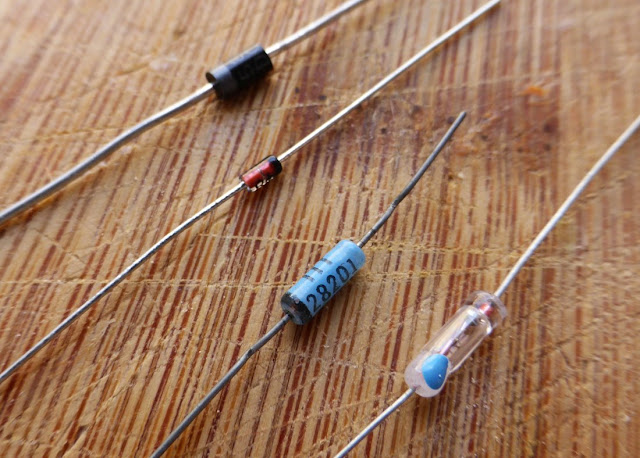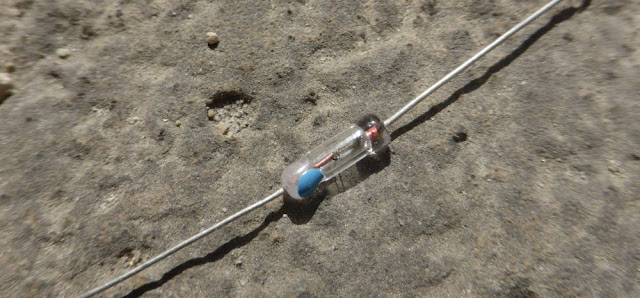
Time for a blog post about it!
What is a diode? How do they work? Which one should I use when making guitar effects?
What exactly is a diode?
In order to understand the differences between the types of diodes, let's see how a diode work. Do not worry, it is not that complex!A diode is a semiconductor. Unlike a resistor, they are polarized with an anode and cathode that is represented on their symbol:

A diode is composed of two parts:
- A part poor in electrons (P junction, like "Positive conduction")
- A part rich in electrons (N junction like "Negative conduction")
At first, electrons do not manage to go through the part rich in electrons and accumulate in the P-junction. When there are enough electrons accumulated, they have enough "power" to cross the N-junction: current is flowing throught the diode!
This phenomenon causes what is called the forward voltage (also called voltage drop): bellow a certain voltage threshold, the current cannot go through the diode. The voltage drop is around 0.7V for a classic silicium diode for instance: below 0.7V, the current will not pass!

If we trace a current vs voltage graph for this, we will have something like this:
Below 0.7V, current does not go through the diode. Above it: it passes!
The voltage drop also diminishes the voltage out the diode. If you make 9V goes through a silicium diode, you will have a 8.3V voltage after the diode!
Finally, another very important thing with diodes is that the current can only go through them in one direction! There is often a really small current that can go the other way, named current leakage. If the current applied is too big, the diode breaks passed what is called the breakdown voltage.
That makes a graph that look like this:

You can find this type of graph in any diode datasheet. You can now read it like a pro! 😃
Depending on the type of diode, the forward voltage / voltage drop changes !
Finally, last but not least, there is of course a maximum forward voltage current, which is the maximum amount of current a diode can handle. In guitar pedals we do not have this problem because currents are somehow quite low in our little stompboxes, but it can be very important when making amplifiers or high-current-draw electronics.
The different types of diodes
There are lots of type of diodes! Here are the most common ones that you will find in guitar effects.Germanium diodes
Here are the famous ones! They are used in vintage effects, but also in modern ones for their special characteristics. They are easy to recognize with their glass capsule style. Their voltage drop is low, around 0.35V, but it can change depending on the model.Here is a D9E germanium diode, used in the famous Klon Centaur:

They are mainly used to distort the signal, but can also be used to correct temperature bias of vintage germanium transistors. Read my circuit analysis of the Tonebender MkIII, there is a germanium diode for that.
Ex: 1n34A, D9E...
Small silicium signal diodes
They are smaller than their germanium counterparts. However, their forward voltage is higher at 0.7V. They are the most used in overdrives and distorsions to generate saturation.
The Big Muff has four of them in its circuit for instance !
Ex: 1n4148, 1n914...
Silicium power diodes
These bulky diodes are a big bigger than signal diodes. Their breakdow voltage is also way higher: they can handle bigger voltages in their wrong polarity. Same voltage drop though, around 0.7V.
They are mainly used to prevent shorts and polarity inversions.
Ex: 1n4001
LED
Often forgotten, they are still diodes and can be used as such!
Their voltage drop is quite high and depend on the LED color :
| Color | Voltage drop |
| Red | 1.7V |
| Orange | 2.0V |
| Yellow/ | 2.1V |
| Green | 2.2V |
| Blue | 3.2V |
Schottky Diode
These diodes, named after M. Schotty, a German physicist, have the lowest forward voltage among diodes : around 0.15V.Therefore, they are very useful to prevent polarity inversion, because the voltage drop is very limited compared to the 0.7V drop of silicium power diodes.
Molecular diodes
For DIY crazy fools like me! In 2017, the
What is a molecular diode ? Instead of letting the P-N junction "empty", there is nanometric layer of organic molecules that is added here. That changes the physical properties of diodes. For instance, current can go both ways!
These diodes are still very hard to find in classic retail. They are more a laboratory experiment type of component, but has Dr Scientist is absolutely awesome, he collaborated with a laboratory and made an effect! There is even a published scientific paper.
How do I choose the diodes?
With guitar effects, what is interesting to us is mainly the voltage drop. Indeed, many distorsions and overdrives work with diodes clipping the signal when it is above or below the forward voltage of diodes, which create saturation!Depending on the diode choosen and their forward voltage, the saturation will be different:

Germanium diode clip at 0.35V more the signal and generate compressed, fat distorsions. Oppositely, a LED with its 1.7V forward voltage will have a more open sound. I use LED on my Dolmen Fuzz to make it sound lighter, almost like a classic drive.
Here is a table to sum it up:
| Type | Voltage drop | Distorsion |
| Schottky | 0.15V | Too much, very compressed |
| Germanium | 0.35V | Big, compressed distorsion |
| Silicium | 0.6V | Classic overdrive to distorsion sounds |
| LED/td> | 1.6V | Open and dynamic saturation |
But that is not it! You can also combine diodes! Two diodes in series will clip the signal less for instance:

It is also possible to make what is called "assymetrical clipping". Just use two diode on one side and one on the other. You can also mix the types of diodes.... Here is a new world of experimentations for you!
Beware! Of course, all of this depend on how the diodes are disposed in the schematic. It works most of the times, but it sometimes can be different. Test it!
Good new is: it is very easy to test diodes with a DPDT switch! Wire it on the diodes pads like I did on my Pharaoh clone:

It is one of the easiest mod to do on overdrive and distortion effects, and very useful to understand how diodes work. So grab a soldering iron and try it!
Protect your circuit against polarity inversions
Diodes can also be used to protect your circuit against polarity inversions... Lets imagine for a minute that a customer of yours invert the battery in your made-with-great-care-and-patience effect.
What can go wrong if I switch the power supply polarity?
If there is no protection diode, there are good chances that a component of your circuit gets damages (especially polarized capacitors...). Or worse, that they heat too much, catch fire or even explode!
To avoid this armagaedon apocalyptical scenario, always add a polarity protection diode. If the polarity of the power supply is inverted, it will not let current pass.

It is a very simple circuit that you should always add to your circuits.
There you go! You know all the basics about diodes! Lets experiment now!
Did you like this blog post? Like the Coda Effects Facebook page or follow Coda Effects on Instagram to know more about the next blog posts releases!
To go further
- Diode basics on SparkFun
- Just Nick video about molecular diodes
- You can buy molecular diodes here! They are expensive though...


4 Comment
Great article. I was curious why Germanium diodes were sought after... now I know! :)
AnswerGood article.
AnswerBut what about zener diodes?
I know! I will try to add something about them later...
AnswerInteresting article. Funnily enough, I've just built a voodoo lab overdrive clone and played with the diodes a bit (first time...) Maybe I need to practice listening some more but couldn't hear a massive difference between stock silicons and LEDs but rather liked the schottky's I tried, nasty in a good way. :)
Answer